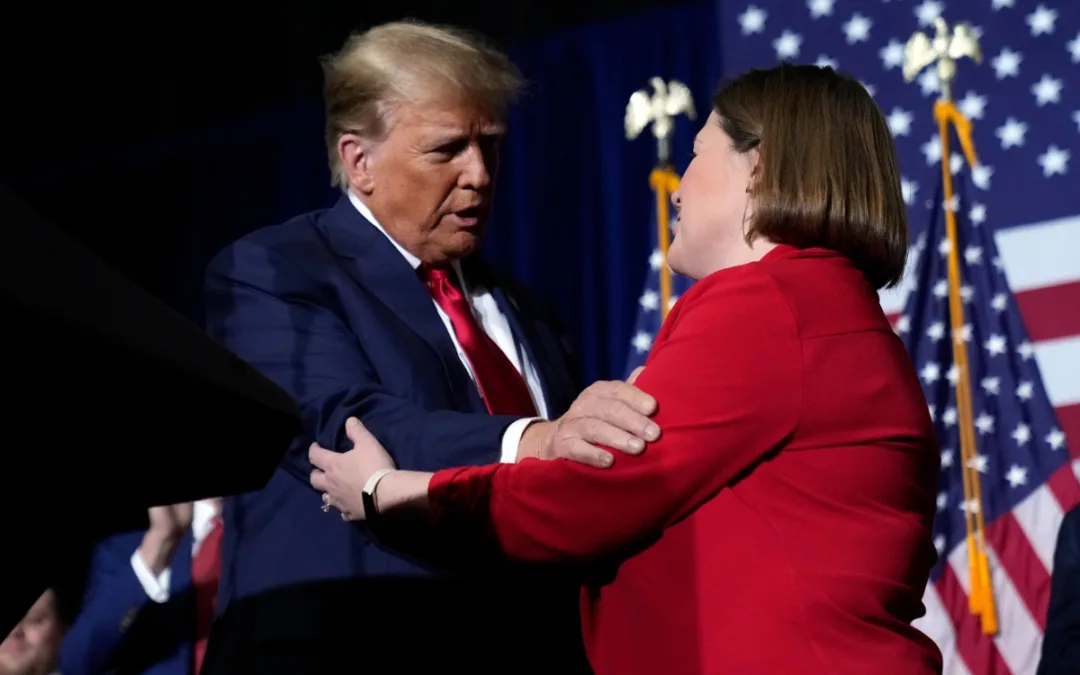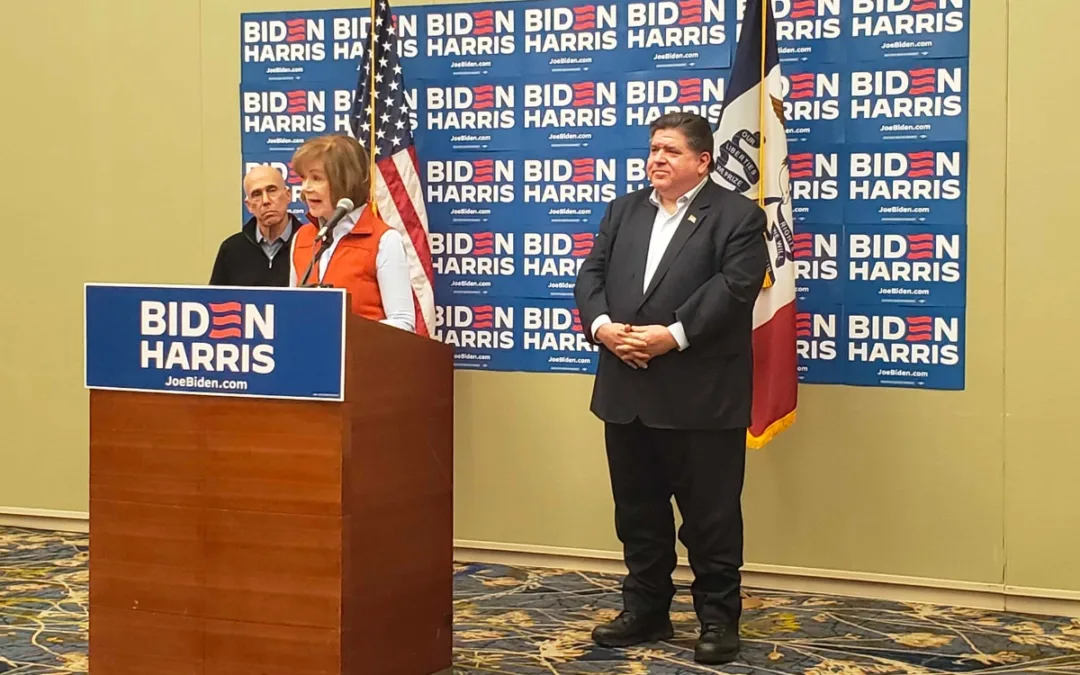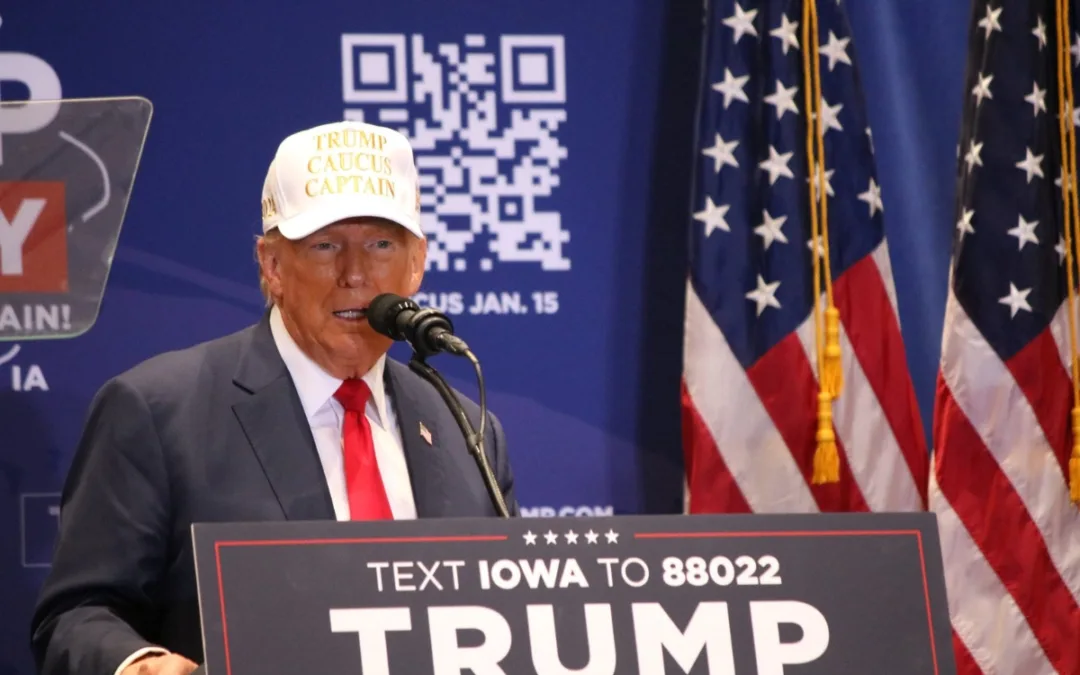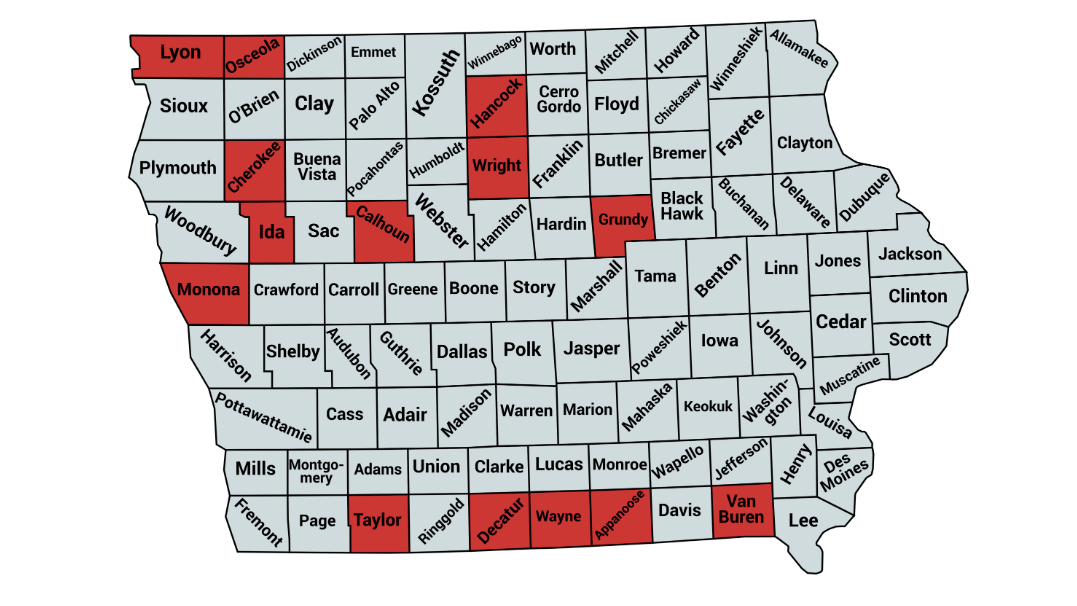
Red counties: two 2020 Dem candidates have visited or less (approximate)
The 99-county tour. It’s been an ambitious goal for anyone looking to win over Iowa voters in every corner of the state. Candidates have completed it and love to talk about it, and it’s become somewhat of a unicorn to chase while campaigning in the state.
It’s a great tool for state races and a lofty ambition for presidential candidates. But is it a necessary condition for success? Or even a good idea?
“You know, a lot has been said about the 99-county tour and a lot of hype from our governor, from Senator Grassley, Senator Ernst, about doing a 99-county tour,” said former Lt. Governor Patty Judge. “Truthfully, it’s not too hard. You know, there are 99 counties, 365 days in a year. You can hit four or five counties in a day.”
Grassley certainly loves the tour, and it’s sometimes been referred to as a “Full Grassley.” He completed his 39th annual 99-county tour in August. His trips, however, have come under criticism because he often only holds public events in Republican-leaning counties, and sticks to private ones in Democratic strongholds. For presidential contenders, it’s expected that all events are open to the public.
And while challenges come along with aiming to complete a 99-county tour, it can have worthwhile benefits for those that complete it.
“I think it’s good to be able to go there and just say that you’ve been there and in every county, but there may not be a lot of people,” Judge said. “There are a handful of people that work very hard and they deserve a pat on the back and a shake of the hand and a thank you. So, I would never say don’t do that.”
[inline-ad id=”3″]
It’s a little different for presidential candidates, though. Some have done it in the past and had success, but it doesn’t hold the same gravity there as it does for state-wide races.
For this presidential caucus cycle, one candidate has already completed it: John Delaney. But it hasn’t yielded any major momentum for his campaign.
Another candidate is set to finish up a 99-county tour tomorrow: Amy Klobuchar.
“From the outset, a key theme of Amy’s campaign has been reaching out to voters wherever they are. There’s no better way to put those words into action than by visiting every county in Iowa,” explained Lauren Dillon, Klobuchar’s state director for Iowa. “Amy believes that for our party to win big in 2020 and advance a progressive agenda, Democrats need to bring people with us instead of shutting them out.”
Sen. Klobuchar passed through the entire southern edge of the state and part of Northwest Iowa over the weekend, hitting 27 counties in just a few days. She’ll complete her 99-county tour with three stops on Friday in Emmet, Kossuth and Humboldt counties.
Counties Low On Visits
There may be a good reason for candidates to not complete a 99-county tour (at least for 2019/2020). First, it takes a lot of time and resources to complete one.
“I guess I’m realistic, because I do understand, with finite resources, to not come to Grundy County,” said Tracy Freese, the Democratic chair for Grundy County, which is just west of Waterloo/Cedar Falls.
There’s also some places that are an unfortunate combination of very deep red, low population, and close enough to bigger places that active Democrats will travel to see candidates.
[inline-ad id=”0″]
Earlier this year, CBS News reporters in Iowa published a twitter thread with maps, showing how frequently each county had been visited. While some of them are not particularly rewarding to go to, some candidates still made the trek.
The 5th Democratic Debate is 75 days before the Iowa Caucuses. @Bidar411 and I did an analysis of where the current candidates have been by county in 2019 & where the candidates on stage tonight have spent their time with maps via @f_l_o_u_r_i_s_h https://t.co/H6BpVcMEfj pic.twitter.com/e9HUhfTnwr
— Adam Brewster (@adam_brew) November 21, 2019
“Tim Ryan came to our county, and two or three people besides my husband and I showed up,” said Kathy Winter, chair for the Osceola County Democrats, a small-population county in Northwest Iowa. “That’s not a good use of their time and resources.”
The Numbers Argument For And Against Small-County Visits
Not every county in Iowa provides a super-tangible reward for showing up there. It’s hard to create the kind of media moments that will carry places on a presidential-campaign schedule. You’re there for shorter events, generally, and the crowds are obviously much smaller, even for the leading candidates.
Osceola County and Grundy County are two counties with the fewest events so far during this presidential cycle. Van Buren (in Southeast Iowa) and Lyon (also in Northwest Iowa) counties are in the same boat: low population, Republican-dominated for years, low turnout to events, and a low electoral reward for doing well there.
“It’s really hard for me to see a candidate use their time and money on a county like ours that gets very low turnout,” Winter explained. “So, to be perfectly honest, when campaigns reach out to me, I always try to approach them with partnering with another county.”
[inline-ad id=”1″]
Between these four counties, they receive a total of just 15 SDEs (state delegate equivalents). For perspective, there’s 2,107 county-based SDEs up for grabs in the 2020 Democratic caucus. That’s four of the 99 counties, worth just around 0.7% of the state’s delegates.
Some Iowa counties aren’t even worth one-tenth of one percent of the total statewide caucus-night delegates. For candidates with limited time, that makes spending a few hours driving to and holding an event in one a questionable use of resources.
But here’s the advantage: every county’s delegate totals are a fixed amount, meaning that running up huge totals in Johnson or Polk counties can only get you so far. You could go all-out in a heavily-populated urban precinct, but regardless of whether you turn out 1,000 or 100 supporters, there’s a set amount of delegates that can be won out of the precinct (or a county at large).
The way the caucuses are designed, it incentivizes candidates to compete in all areas of the state. If you ignore rural areas and fail to hit the 15% viability threshold in many precincts in a county, you could end up getting wiped out in the low-delegate counties.
Viability becomes even more important in such a crowded field as this, where no candidate, regardless of where they’re polling, is likely to hit 15% in every single precinct.
That’s where another advantage to smaller counties come in. The way rural counties’ smaller populations and precincts are more spread out, you may only need 10 or 15 supporters to hit viability in some precincts. Compare that to a place like Ankeny, a fast-growing Des Moines suburb, where showing up with 100 people in your corner on caucus night may not be enough to stay viable and earn delegates.
So when Klobuchar drew 26 people to a Corydon coffee shop in Wayne County (one of those one-tenth of one percent total delegate counties), if she won the room over, that may get her to viability in a few precincts in the county. If she drew triple the number at an Urbandale stop (another Polk County suburb), winning all present might not even make her viable to a single precinct there.
Again, those smaller counties are worth far less in terms of delegates, but they are still worth something, and adding up a bunch of wins in smaller counties can eventually add up. To fully add up, of course, you have to hit a lot of them.
[inline-ad id=”2″]
A Struggle to be Seen
Regardless of whether they visit all 99 of Iowa’s counties, Democratic presidential candidates have clearly prioritized both rural outreach and policy development this cycle, in part to find a way to improve their margins in the areas that Trump carried so well.
“This challenge also means opportunity,” explained J.D. Scholten, Democratic congressional candidate for Iowa’s fourth district. “These counties are on the forefront of the challenges facing rural America, like losing grocery stores, school and hospital closures, and lack of investment, that don’t make the national headlines, and are different from the challenges facing the bigger cities of Iowa.”
Part of the issue, however, is the opportunity to communicate that message. Often times, these communities don’t have media infrastructure that delivers frequent political reporting. Most rural counties have a weekly paper, but many of them do not have political writers.
“You know, you have to spend your time and your resources where you can gather the most votes. And so, I’ve done the 99 many, many times. And I think that’s fine,” Judge said. “But you also know that you’ve got to spend the resources where you’ve got a TV camera, where you get a friendly newspaper, so forth.”
[signup_form]
Doing Regional Events
Finding a balance is key. Presidential candidates, especially those who have busy jobs, don’t have as much freedom to set out on a full 99-county tour (though Klobuchar did it with her Senate schedule). But you can still meet plenty of the most-engaged Democratic voters with regional events.
“I don’t spend a lot of time feeling bad that the candidates don’t come to Osceola County, because I really think, you know, they need to get the most bang for their buck on their stop,” Winter explained.
However, not visiting any county in the area is a mistake, she added.
“I hate it when they never come out of Sioux City. That bothers me,” Winter said. “If they consider their visit to Northwest Iowa is Sioux City, then I’m a bit annoyed.”
[inline-ad id=”4″]
Accessibility doesn’t mean literally walking up to their front doorstep. Most are willing to make arrangements to travel a bit to see a candidate, especially those Democrats in low-population, deep-red counties. People in these areas of the state are used to longer drives, anyway, going to nearby larger cities from time to time for shopping.
“We’re gonna go over to Black Hawk County, or we’re gonna go to Iowa Falls,” Freese, from Grundy County, said. “We get that, we totally understand, or go down to Marshalltown or something. We get it. We know what to do. And that’s what I would tell you, I think a lot of us who are active, we are realistic that this is not where your best use of time and resources are.”
How Local Democrats Are Trying To Help
Democrats in rural area have started to come up with solutions for their own problem. One of the popular answers is partnership; rather than have a presidential candidate come to every county, they’re hosting their own ‘cattle-call’ events to create an exciting opportunity for rural Democrats to meet the candidates.
“I was a big promoter of the Summer Sizzler, over in Dickinson County,” Winter explained, about the Spirit Lake event that over a dozen county Democratic parties coordinated on. “It’s only thirty-five miles from here. You know, there were several candidates. But to me, I guess maybe because we are from a rural area, that’s not what I consider an unreasonable distance to drive.”
[inline-ad id=”4″]
Freese is now working on an event like this for January, to partner with counties around Grundy County.
They’re hoping to get at least a handful of candidates to show up and make their case – a much more attractive option than doing a solo event.
“We can never get a critical mass in a county that’s under 10,000 in population and tends to vote Republican. But if we can partner with five or six counties around and we have an event and we have 100 to 200 people at that event, then it’s worth it for a candidate to come,” Judge said. “We’ve been doing it in Southern Iowa. We’ve got six or seven counties that go together every year, have an event.”
Winter has also been advocating for this strategy for Northwest Iowa. In fact, she generally tries to talk the campaigns out of their desire to complete the 99-county tour.
She doesn’t see that as a pessimistic thing to do. Rather, Winter is trying to use her knowledge to help the campaigns be efficient with their resources. After all, the goal should be to get in front of as many voters as possible, and do so in a meaningful way.
“I don’t harangue them to come. I don’t blame them that they don’t come. And when they call me about coming, I usually try to talk them into some sort of a partnership, especially O’Brien County, we work real well together,” Winter said. “So, I try to say, well, hey, you know, why don’t you come to one county or the other, but it’s really not a good use of your resources to come to both.”
By Josh Cook
Posted 12/26/19
Politics
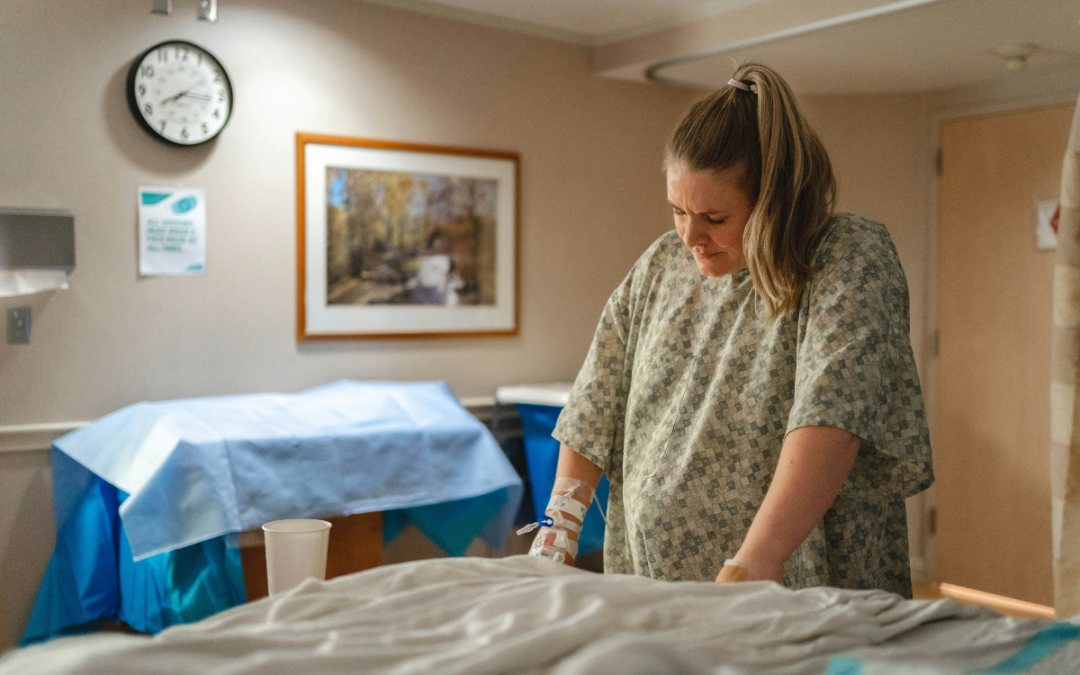
It’s official: Your boss has to give you time off to recover from childbirth or get an abortion
Originally published by The 19th In what could be a groundbreaking shift in American workplaces, most employees across the country will now have...

Trump says he’s pro-worker. His record says otherwise.
During his time on the campaign trail, Donald Trump has sought to refashion his record and image as being a pro-worker candidate—one that wants to...
Local News

No more Kum & Go? New owner Maverik of Utah retiring famous brand
Will Kum & Go have come and gone by next year? One new report claims that's the plan by the store's new owners. The Iowa-based convenience store...

Here’s a recap of the biggest headlines Iowa celebs made In 2023
For these famous Iowans, 2023 was a year of controversy, career highlights, and full-circle moments. Here’s how 2023 went for the following Iowans:...


